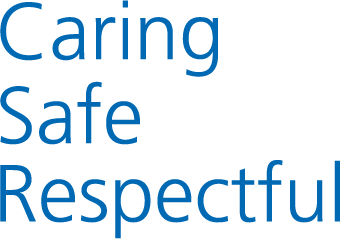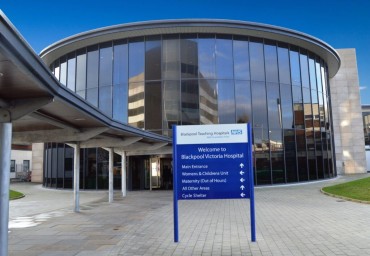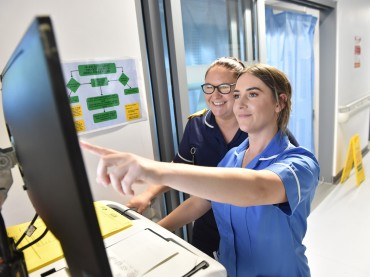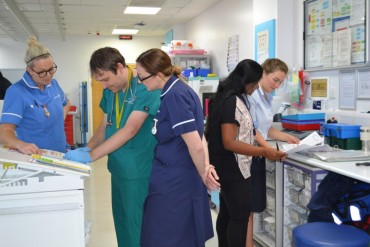What we do
The Acute Stroke and Rehabilitation Unit (ASRU) is located on the ground floor of Blackpool Victoria Hospital beside X-ray Central. The Unit has 29 beds in total – 16 Acute and 13 Rehabilitation beds.
There is a rapid-access TIA (Transient Ischaemic Attack or mini-stroke) clinic held Monday to Friday afternoons, with established access to vascular surgery expertise based at Royal Preston Hospital. This clinic is supported by same-day carotid doppler, which is used to scan the arteries of the neck. Same-day CT brain scanning is also available.
Patients who have suffered a stroke are initially brought to the A&E department at Blackpool Victoria Hospital, usually by ambulance. Patients are assessed by a member of the Stroke team (such as a specialised stroke nurse) as soon as possible upon arrival, and are then moved to the Stroke Unit for treatment.
The Stroke team is made up of doctors, nurses, healthcare assistants, assistant practitioners (APs), housekeepers, ward clerks, physiotherapists, occupational therapists, dieticians, and speech and language therapists. They have the full support of the hospital discharge and early supported discharge teams, who co-ordinate patient discharge and provide support for patients once they leave the Stroke Unit. There are also close links between the Stroke team and the community therapy team.
Patients on the Stroke Unit are cared for by a team of three Consultant Stroke Physicians, an extensive nursing team including nine stroke nurse specialists, and therapists with specialist stroke knowledge in both acute and rehabilitation care. Patients will be seen by several members of the Stroke team to assess any disabilities following a stroke, and the team will work to help patients recover as much and as quickly as possible.
To ensure that we provide the most effective care for stroke patients, staff can take advantage of ongoing training and development opportunities.
As every stroke is unique, there are a wide range of potential issues that might be faced by each patient. Therefore, it is important for patients to discuss any problems or concerns with the Stroke team.
During rehabilitation, we provide a print out of the outcomes of the weekly multi-disciplinary meeting, which is placed in the patients’ bedside folder for them to read and provide comment. Ongoing care is individually planned for each patient, to maintain progress and to help patients adjust to life once they leave hospital.
More information on treatment and rehabilitation following stroke is available from the Stroke Association website here.
If you are visiting a friend or relative on the Stroke Unit, parking is available in pay and display car parks across the Blackpool Victoria Hospital site. Disabled car parking bays are available for Blue Badge holders. Buses also run regularly to and from the hospital, with the majority of services arriving at and departing from the new main entrance building.
Access to the Stroke Unit is via the main corridor on the ground floor of the main hospital building.
In line with present Trust guidelines, visiting times on the Stroke Unit are as follows:
3:00pm – 5:00pm (Every day)
6:00pm – 8.00pm (Every day)
To arrange a visit outside of this time, please speak to the nurse in charge.
A stroke occurs when the blood supply to the brain is interrupted. The lack of blood supply starves the brain cells of oxygen and nutrients, causing brain cell damage.
The most common type of stroke occurs when a blood clot blocks the flow of blood in an artery. This is called an ischaemic stroke. Sometimes a blood vessel bursts, causing bleeding into the brain. This is called a haemorrhagic stroke.
Is the stroke stress-related?
No direct link has been demonstrated between stroke and stress, but there is a relationship between stroke and high blood pressure. The aim is to achieve a systolic blood pressure (the top number on a blood pressure test) of less than 140. Lowering blood pressure lowers the risk of stroke.
What are the risks of a second stroke?
The risk of having a stroke is increased after the initial stroke but medications to make your blood less sticky (anti-platelets); lower blood pressure (anti-hypertensives); and lower cholesterol (statins) will reduce your risk. It is essential that you do not smoke. You can reduce the risk further by making other changes to your lifestyle such as doing regular (daily) exercise and eating a healthy diet.
What is Thrombolysis?
If a patient’s stroke is caused by a blood clot, they may be treated with a clot-busting drug to try to dissolve the clot and reopen the blocked artery. The sooner this treatment is given the better the chance of a good outcome. As time passes clots harden and become more difficult to dissolve. Ideally, thrombolysis should be started within one hour of a stroke but can be given up to four and a half hours. Evidence demonstrates that, where appropriate, if patients are given the clot-busting drugs within three hours of the onset of their symptoms, they will be able to recover more quickly, reduce disability and have a better quality of life. However, not all patients presenting within the time window will be eligible for this treatment, and the decision to treat will be made by a stroke consultant. They will discuss the risks and benefits of this treatment with patients and relatives.
What is Telemedicine and TeleStroke?
Telemedicine is the use of digital technology to allow hospital doctors to give a virtual assessment for stroke patients. The hospital team can call a specialist stroke clinician for advice and guidance using a video-link; this doctor can then speak to both the patient and the hospital team, and can access test results and scans to help them make a decision on treatment.
TeleStroke is a regional telemedicine service, which enables stroke patients at Blackpool Victoria Hospital to receive access to thrombolysis outside normal working hours. Clinicians from across the Lancashire and Cumbria take part in a rota to assess patients, review CT head scans and give advice to the hospital team via a live video link. This technology enables patients who present at their local hospital with the symptoms of stroke to receive thrombolysis therapy, even outside of normal working hours.
Where can I find more information?
More information and support for stroke patients is available from the following organisations:
- NHS UK: http://
www. nhs.uk/ Conditions/ Stroke/ Pages/ Introduction.aspx - Shaw Trust: shaw-trust.org.uk
- The Stroke Association: Stroke.org.uk
- Different Strokes: differentstrokes.co.uk
NHS UK: http://www.nhs.uk/Conditions/Stroke/Pages/Introduction.aspx
Shaw Trust: shaw-trust.org.uk
The Stroke Association: Stroke.org.uk
Different Strokes: differentstrokes.co.uk



